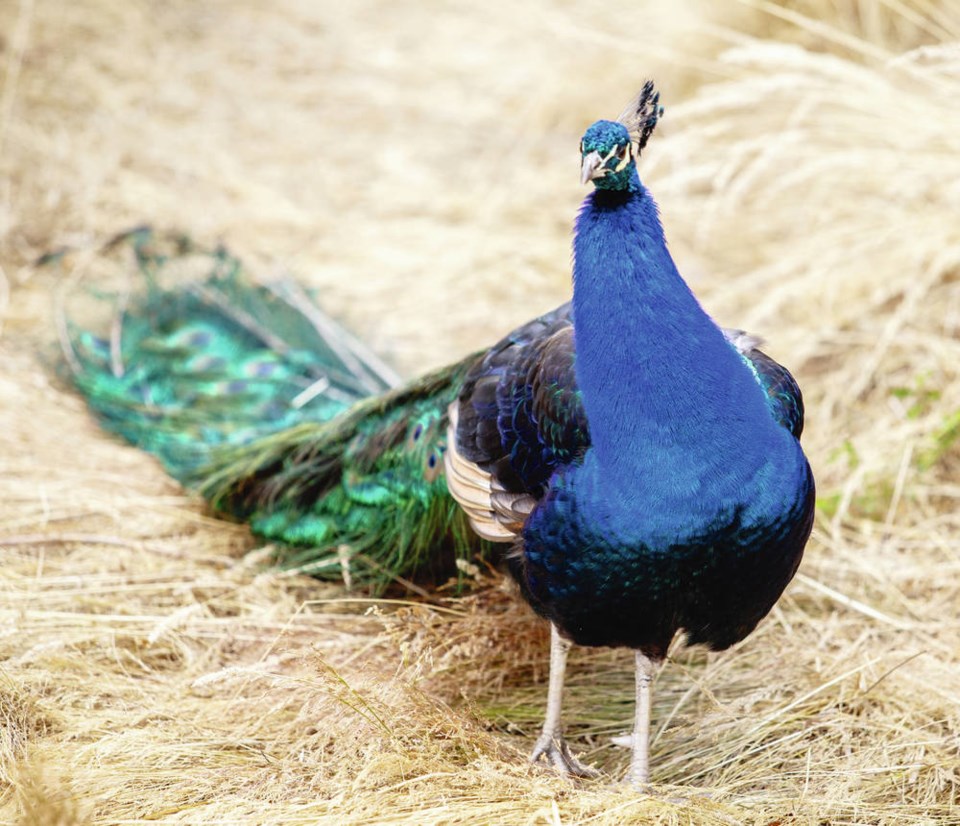So, Buck and I are cruising through Oak Bay when suddenly there’s this super-loud scream, like Yoko Ono stubbing her toe while singing in the shower.
“Maybe somebody just saw their property tax notice,” said Buck.
No, it turned out to be a peacock. “Sorry to alarm you,” the bird said. “I’m looking for a mate.”
Just kidding. A peacock would never apologize. They have too much swagger for that. Haughty, noisy, messy, bold and oh-so-aware of their stunning good looks, peacocks are basically frat boys. Give them a Camaro and a puka-shell necklace, and John Hughes would have cast them in a 1980s teen movie.
They are also, according to social media, popping up all over the south end of Greater Victoria — UVic, Willows Beach, Uplands, Fairfield. Birds based in Beacon Hill Park often range into residential areas in the spring, but Facebook has been aflutter (as it were) about this year’s peacock proliferation.
“We’ve seen an increase in peacocks calls,” confirms Ian Fraser, the manager of Victoria Animal Control Services.
The big question is why. Maybe birds are wandering because there hasn’t been as much food in the park. Or maybe it’s less a matter of more peacocks roaming more widely than of more people being around to see them. Fraser says all manner of animal complaints spiked as soon as the pandemic began. “It was just because more people were at home.”
The one thing that’s certain: Peafowl (peacocks are male, peahens female) are polarizing.
Some people love them. They are regal and enchantingly serene as they slowly go about life. When a cherished peahen that lived around Moss Rock was killed by a car this week, neighbours expressed genuine sorrow.
Others loathe them. Someone once called 911 to breathlessly report that “peacocks have escaped Beacon Hill Park.” Two weeks ago, a bird in Humboldt County, California was shot to death after someone posted a Craiglist ad seeking a hitman to take out a disruptive peacock “by any means necessary.”
And sometimes perspective depends on the time of day. Peacock popularity fades when it’s mating season and they’re hollering like 3 a.m. drunks.
That’s when people like Fraser get called in to haul them back to the park. You might recall Pedro Arrais’s story from this time last year when an amorous peacock not only chose the entrance of an across-Douglas-Street apartment building as the place to perform for his harem of peahens, but gashed the arm of a 90-year-old resident. (“Sex-crazed peacock put in ‘bird prison’ after vicious attack on elderly woman,” screeched the headline when Britain’s Daily Star tabloid picked up the story.) It took several catch-and-release trips before the peacock decided to stay in the park, where the city guesstimated that roughly 40 Indian peafowl (they’re classified as a domestic species living wild) roamed free.
It’s extremely rare for a peacock to go after a human. More often they’re a danger to themselves. “They will attack and attack and attack their own reflections to the point they hurt themselves,” Fraser says.
The reflection, which they assume to be a rival, doesn’t have to be in a window. A shiny black car will do, says well-known (and wonderfully named) Victoria birder Ann Nightingale.
“They’re not the brightest birds around,” she says.
They are interesting, though. Sometimes peacocks will use flat-fronted buildings like that Douglas Street apartment tower to amplify their mating calls. “What they’re looking for is a way of being as loud as possible,” Nightingale says. They like to roost high up, will fly into the lower limbs of a tree, then hop their way up toward the top, one branch at a time. “You can get a whole tree full of peacocks and peahens.”
And then there are those long trains of feathers (they’re not really tailfeathers, by the way) that the males fan and shake during mating season, but then later shed. “They grow like an annual plant.”
The feathers are what sometimes entice people into getting peacocks as pets, which seems like a terrific idea until they eat your dogfood, you’re slipping on peacock poop and those wake-the-dead bird calls begin. Told that peacocks have been spotted roadside in far-off wilderness locations on Vancouver Island, Nightingale speculated that they had been taken for a midnight ride and abandoned by owners suffering from buyer’s remorse. Or, more likely, by the owners’ neighbours.
As for those peacocks popping up around Victoria, they likely just relocated on their own, walking or winging it, sort of, for short distances. “They are birds,” Nightingale says. “They can fly.”
That makes peacocks notoriously difficult to catch. When the X-Men movies were shot at Royal Roads University, attempts to round up the peafowl living on the university grounds met with limited success. In the end, the film company hired a peacock wrangler to feed the birds and keep them quiet when the director yelled “action!”
Fraser can sympathize. Recently, a fugitive peacock all but gave him a rude gesture after flying to the top of a Fairfield roof. “That bird is mocking you,” said a woman at a nearby bus stop. Yes, Fraser acknowledged, it was. “We walked away with our tails between our legs.”
The good news? Peafowl eventually end up going home anyway. “They just about always return to the park.”



